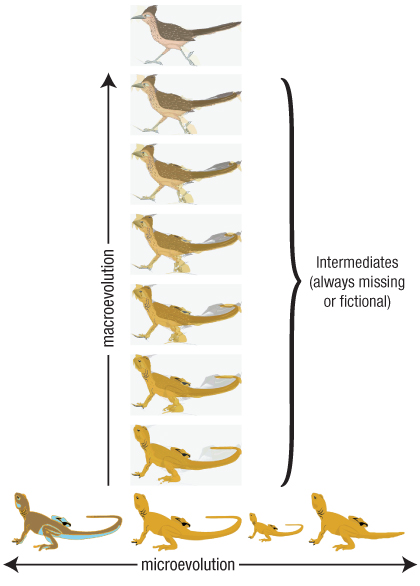Below is the online edition of In the Beginning: Compelling Evidence for Creation and the Flood,
by Dr. Walt Brown. Copyright © Center for Scientific Creation. All rights reserved.
Click here to order the hardbound 8th edition (2008) and other materials.
Life Sciences
Before considering how life began, we must first understand the term “organic evolution.” Organic evolution, as theorized, is a naturally occurring, beneficial change that produces increasing and inheritable complexity. Increased complexity would be shown if the offspring of one form of life had a different and improved set of vital organs. This is sometimes called the molecules-to-man theory—or macroevolution. [See Figure 4 on page 7.] Microevolution, on the other hand, does not involve increasing complexity. It involves changes only in size, shape, or color, or minor genetic alterations caused by one or more mutations. Each example of macroevolution would require thousands of “just right” mutations. Microevolution can be thought of as horizontal (or even downward) change, whereas macroevolution, if it were ever observed, would involve an upward, beneficial change in complexity. Therefore, microevolution plus time will not produce macroevolution. (micro + time ≠ macro)
Creationists and evolutionists agree that microevolution (and natural selection) occur. Minor change has been observed since history began. But notice how often evolutionists give evidence for microevolution to support macroevolution. It is macroevolution—which requires new abilities and increasing complexity, resulting from new genetic information—that is at the center of the creation-evolution controversy. Therefore, in this book, the term “organic evolution” will mean macroevolution.

Figure 4: Microevolution vs. Macroevolution. Notice that macroevolution would require an upward change in the complexity of certain traits and organs. Microevolution involves only “horizontal” (or even downward) changes—no increasing complexity. Also note that all creationists agree that natural selection occurs. While natural selection does not result in macroevolution, it accounts for many variations within a very narrow range.
Science must always base conclusions on what is seen and reproducible. So what is observed? We see variations in lizards, four of which are shown at the bottom. We also see birds, represented at the top. In-between forms (or intermediates), which should be vast in number if macroevolution occurred, are never seen as fossils or living species. A careful observer can usually see unbelievable discontinuities in these claimed upward changes, as well as in the drawing above.
Ever since Darwin, evolutionists have made excuses for why the world and our fossil museums are not overflowing with intermediates.
(Most readers will want to read the accompanying references, quotations, and notes beginning on page 52.)